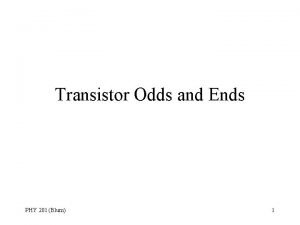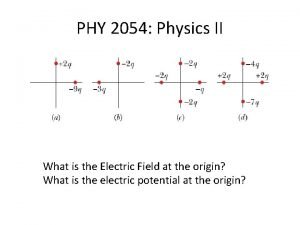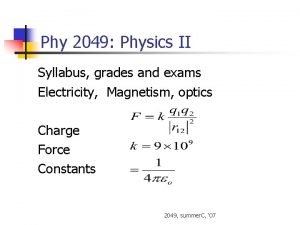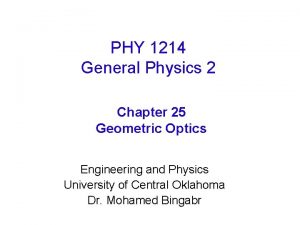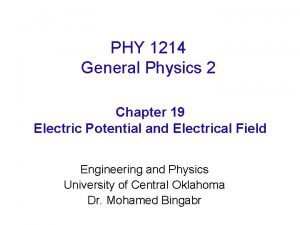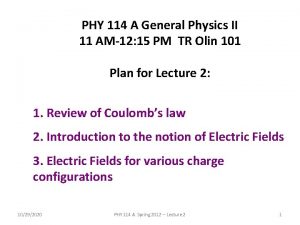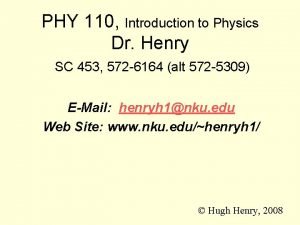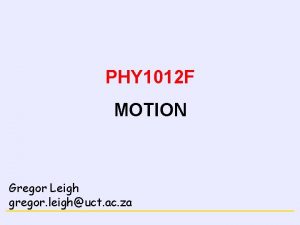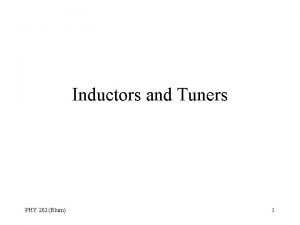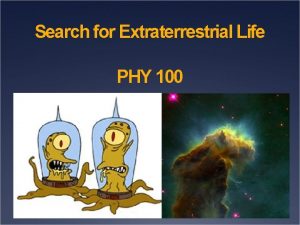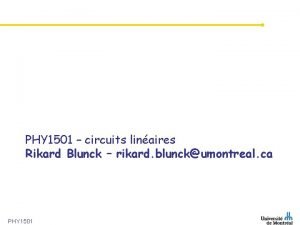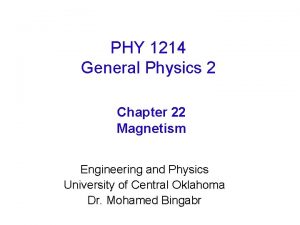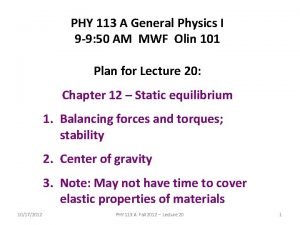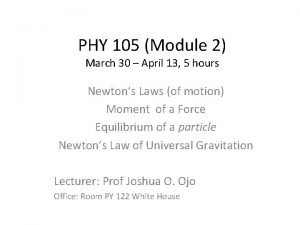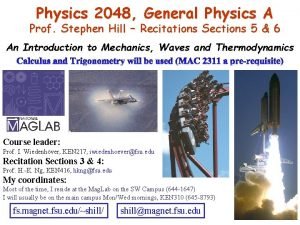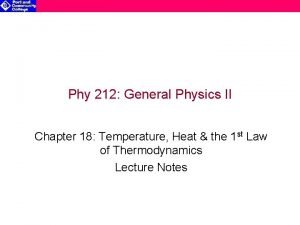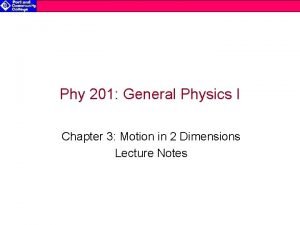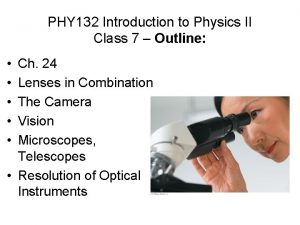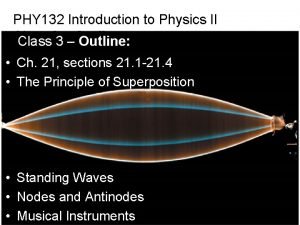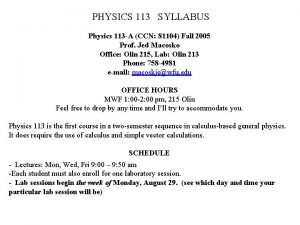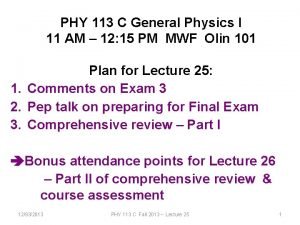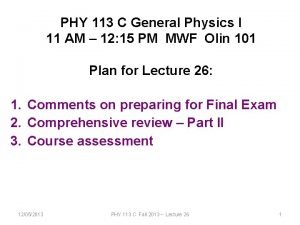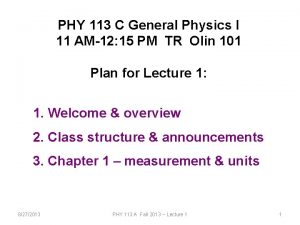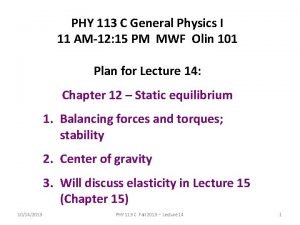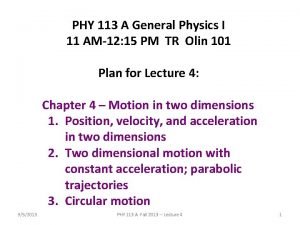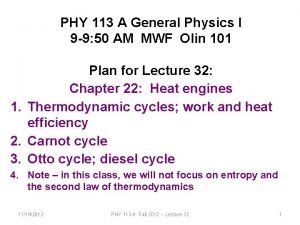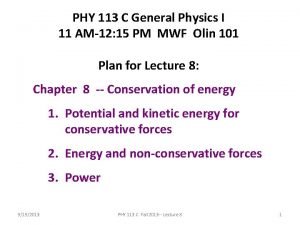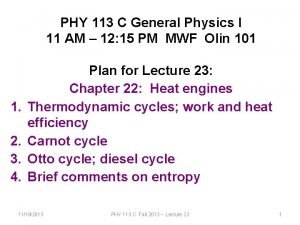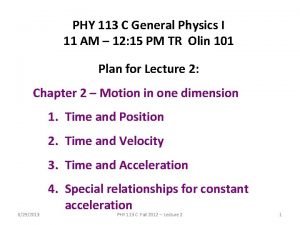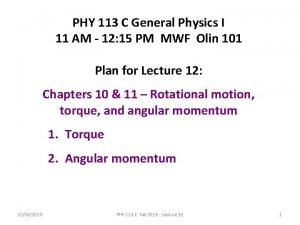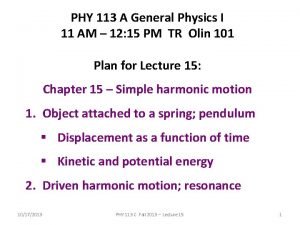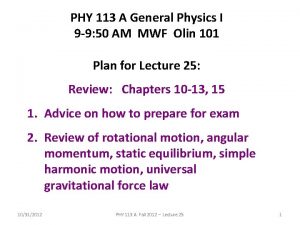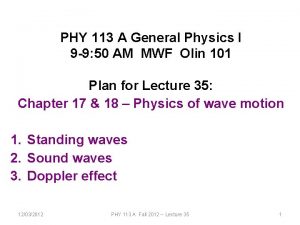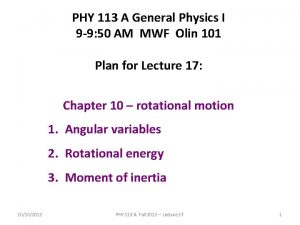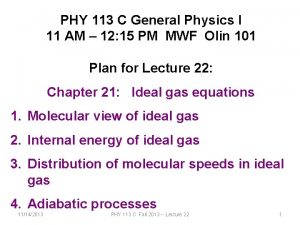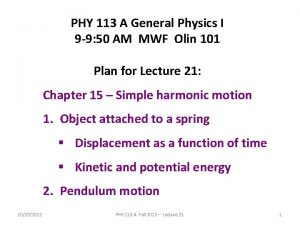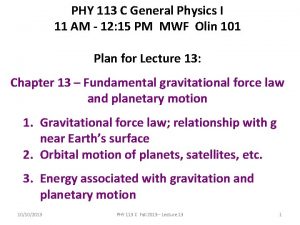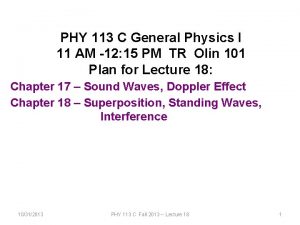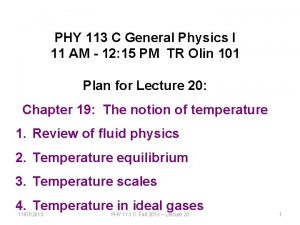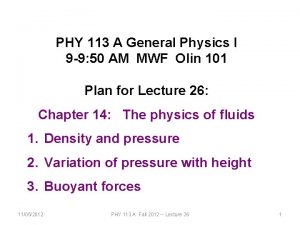PHY 113 C General Physics I 11 AM

































- Slides: 33

PHY 113 C General Physics I 11 AM – 12: 15 PM MWF Olin 101 Plan for Lecture 10 Chapter 9 -- Linear momentum 1. Impulse and momentum 2. Conservation of linear momentum 3. Examples – collision analysis 4. Notion of center of mass 10/01/2013 PHY 113 C Fall 2013 -- Lecture 10 1

10/01/2013 PHY 113 C Fall 2013 -- Lecture 10 2

Summary of physics “laws” 10/01/2013 PHY 113 C Fall 2013 -- Lecture 10 3

Another way to look at Newton’s second law: iclicker question: Why would you want to define linear momentum? A. To impress your friends. B. To exercise your brain. C. It might be helpful. D. To distinguish it from angular momentum. 10/01/2013 PHY 113 C Fall 2013 -- Lecture 10 4

Relationship between Newton’s second law and linear momentum: (if m is constant) 10/01/2013 PHY 113 C Fall 2013 -- Lecture 10 5

10/01/2013 PHY 113 C Fall 2013 -- Lecture 10 6

Suppose that a tennis ball with mass m=0. 057 kg approaches a tennis racket at a speed of 45 m/s. What is the impulse the racket must exert on the ball to return the ball in the opposite direction at the same speed. Assume that the motion is completely horizontal. 10/01/2013 PHY 113 C Fall 2013 -- Lecture 10 7

Example: A 1500 kg car collides with a wall, with vi= -15 m/s and vf=2. 6 m/s. What is the impulse exerted on the car? 10/01/2013 PHY 113 C Fall 2013 -- Lecture 10 8

Example of graphical representation of F(t) 10/01/2013 PHY 113 C Fall 2013 -- Lecture 10 9

Physics of composite systems 10/01/2013 PHY 113 C Fall 2013 -- Lecture 10 10

Example – completely inelastic collision; balls moving on a frictionless surface 10/01/2013 PHY 113 C Fall 2013 -- Lecture 10 11

Energy loss in this example: 10/01/2013 PHY 113 C Fall 2013 -- Lecture 10 12

Example – completely elastic collision; balls moving on a frictionless surface 10/01/2013 PHY 113 C Fall 2013 -- Lecture 10 13

Completely elastic collision; numerical example: 10/01/2013 PHY 113 C Fall 2013 -- Lecture 10 14

iclicker exercise: We have assumed that there is no net force acting on the system. What happens if there are interaction forces between the particles? A. Analysis still applies B. Analysis must be modified 10/01/2013 PHY 113 C Fall 2013 -- Lecture 10 15

Example from homework: 10/01/2013 PHY 113 C Fall 2013 -- Lecture 10 16

Example from homework: -- continued iclicker question Do you expect Kf-Ki to be A. >0 B. <0 10/01/2013 PHY 113 C Fall 2013 -- Lecture 10 17

Another example: before vf after 10/01/2013 PHY 113 C Fall 2013 -- Lecture 10 18

Examples of two-dimensional collision; balls moving on a frictionless surface 10/01/2013 PHY 113 C Fall 2013 -- Lecture 10 19

Examples of two-dimensional collision; balls moving on a frictionless surface 10/01/2013 PHY 113 C Fall 2013 -- Lecture 10 20

Example: two-dimensional totally inelastic collision m 1=1500 kg m 2=2500 kg 10/01/2013 PHY 113 C Fall 2013 -- Lecture 10 21

iclicker exercise: Can this analysis be used to analyze a real collision? A. Of course! The laws of physics must be obeyed. B. Of course NOT! In physics class we only deal with idealized situations which never happen. 10/01/2013 PHY 113 C Fall 2013 -- Lecture 10 22

Another example of 2 -dimensional elastic collision: vf m vi m 10/01/2013 PHY 113 C Fall 2013 -- Lecture 10 23

Energy analysis of a simple nuclear reaction : Q=4. 87 Me. V 10/01/2013 PHY 113 C Fall 2013 -- Lecture 10 24

Energy analysis of a simple reaction : Q=4. 87 Me. V 10/01/2013 PHY 113 C Fall 2013 -- Lecture 10 25

Elastic collision in two dimensions 10/01/2013 PHY 113 C Fall 2013 -- Lecture 10 26

Elastic collision in two dimensions -example of elastic proton-proton scattering 10/01/2013 PHY 113 C Fall 2013 -- Lecture 10 27

Elastic collision in two dimensions -example of elastic proton-proton scattering 10/01/2013 PHY 113 C Fall 2013 -- Lecture 10 28

The notion of the center of mass and the physics of composite systems 10/01/2013 PHY 113 C Fall 2013 -- Lecture 10 29

10/01/2013 PHY 113 C Fall 2013 -- Lecture 10 30

Finding the center of mass 10/01/2013 PHY 113 C Fall 2013 -- Lecture 10 31

Example from webassign : m 1 y m 2 m 3 m 4 10/01/2013 PHY 113 C Fall 2013 -- Lecture 10 x 32

Finding the center of mass For a solid object composed of constant density material, the center of mass is located at the center of the object. 10/01/2013 PHY 113 C Fall 2013 -- Lecture 10 33
 Phy 113 past questions and answers
Phy 113 past questions and answers Phy 131 past papers
Phy 131 past papers Pa msu
Pa msu The great orthogonality theorem
The great orthogonality theorem Phy 221 msu
Phy 221 msu Phy theorem
Phy theorem Phy 121 asu
Phy 121 asu Ddr phy architecture
Ddr phy architecture Phy 205
Phy 205 Eye accommodation
Eye accommodation Phy 2049
Phy 2049 Phy
Phy Phy
Phy Phy
Phy Atm basics
Atm basics Fizik ii
Fizik ii Phy 2049
Phy 2049 Real image
Real image Phy 1214
Phy 1214 Phy
Phy Law of motion
Law of motion Phy
Phy Phy
Phy Life phy
Life phy Rikard blunck
Rikard blunck Applications of magnetism
Applications of magnetism 2012 phy
2012 phy Phy-105 5 discussion
Phy-105 5 discussion Phy 2048c fsu
Phy 2048c fsu Phy 212
Phy 212 General physics measurement
General physics measurement Vx=vox+axt
Vx=vox+axt Phy 132 lecture 10: ch30
Phy 132 lecture 10: ch30 Phy 132
Phy 132













